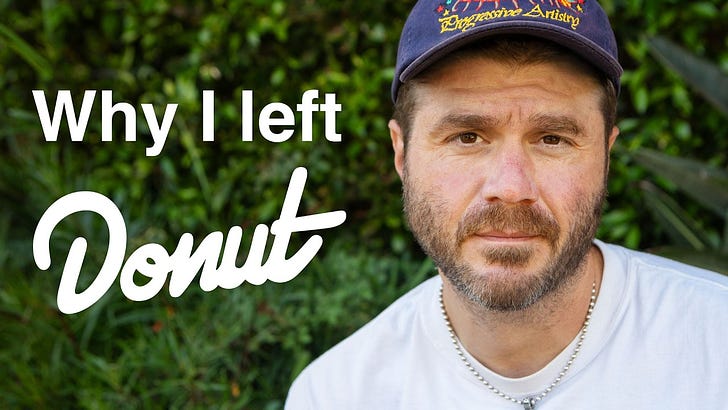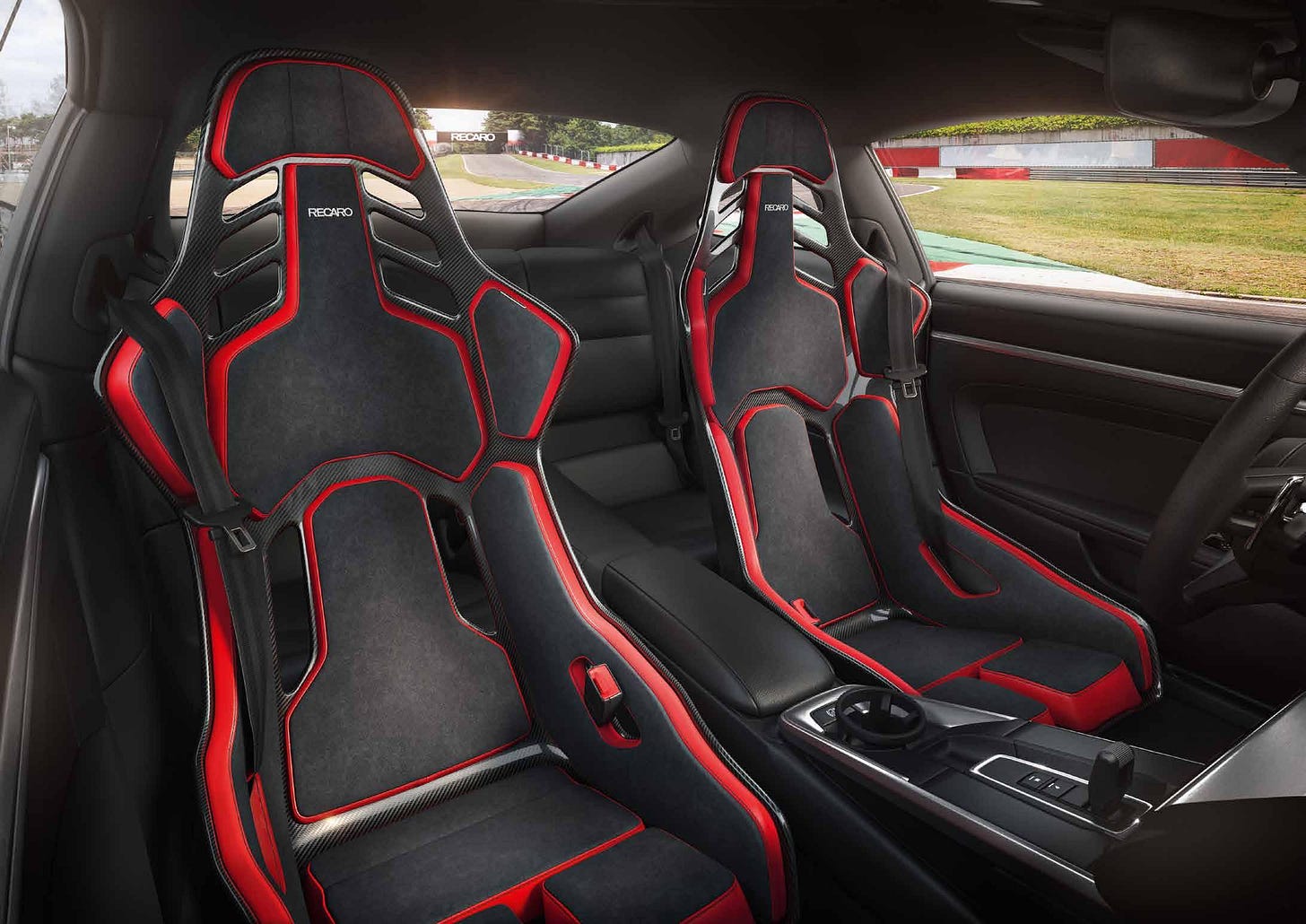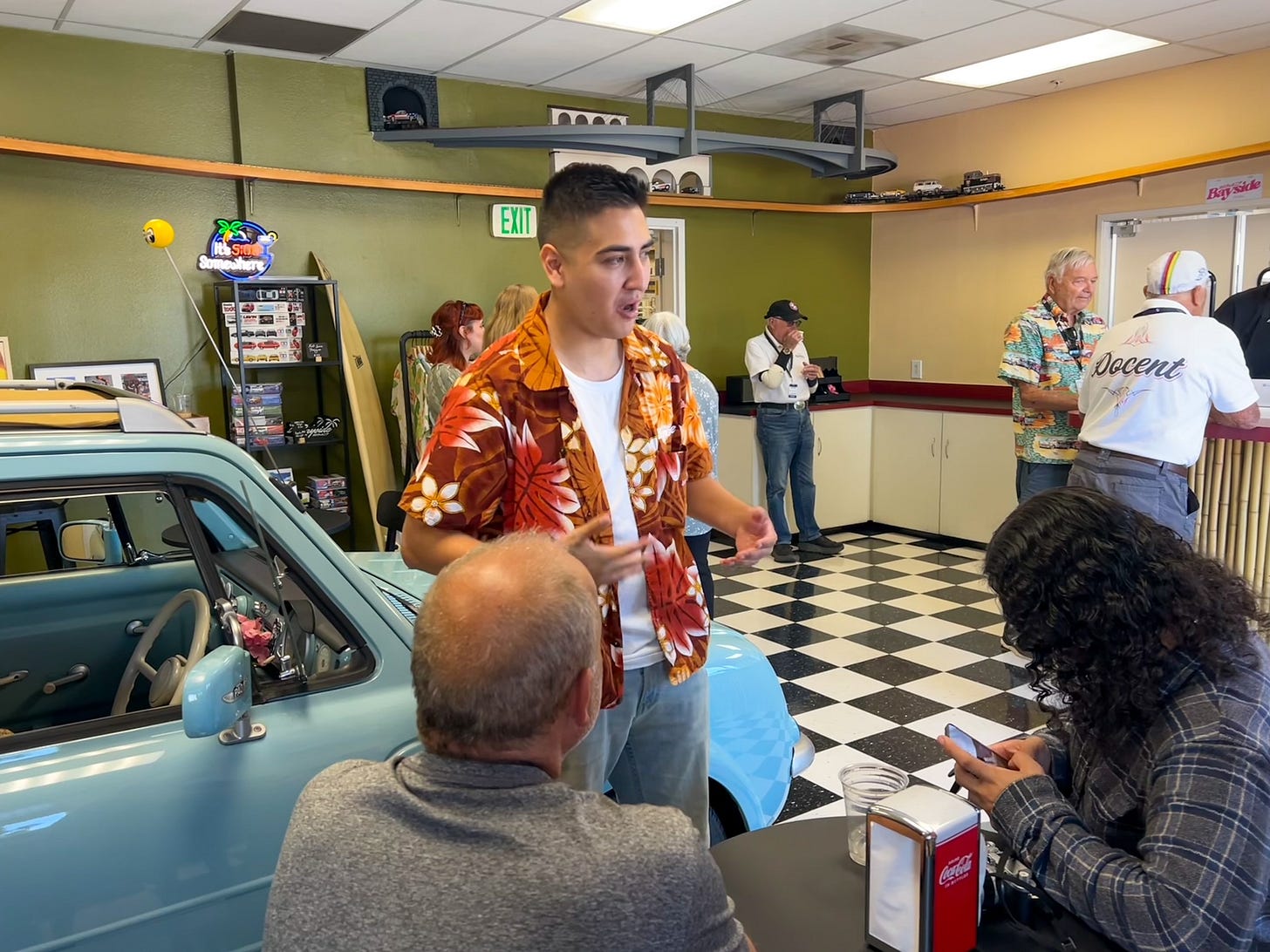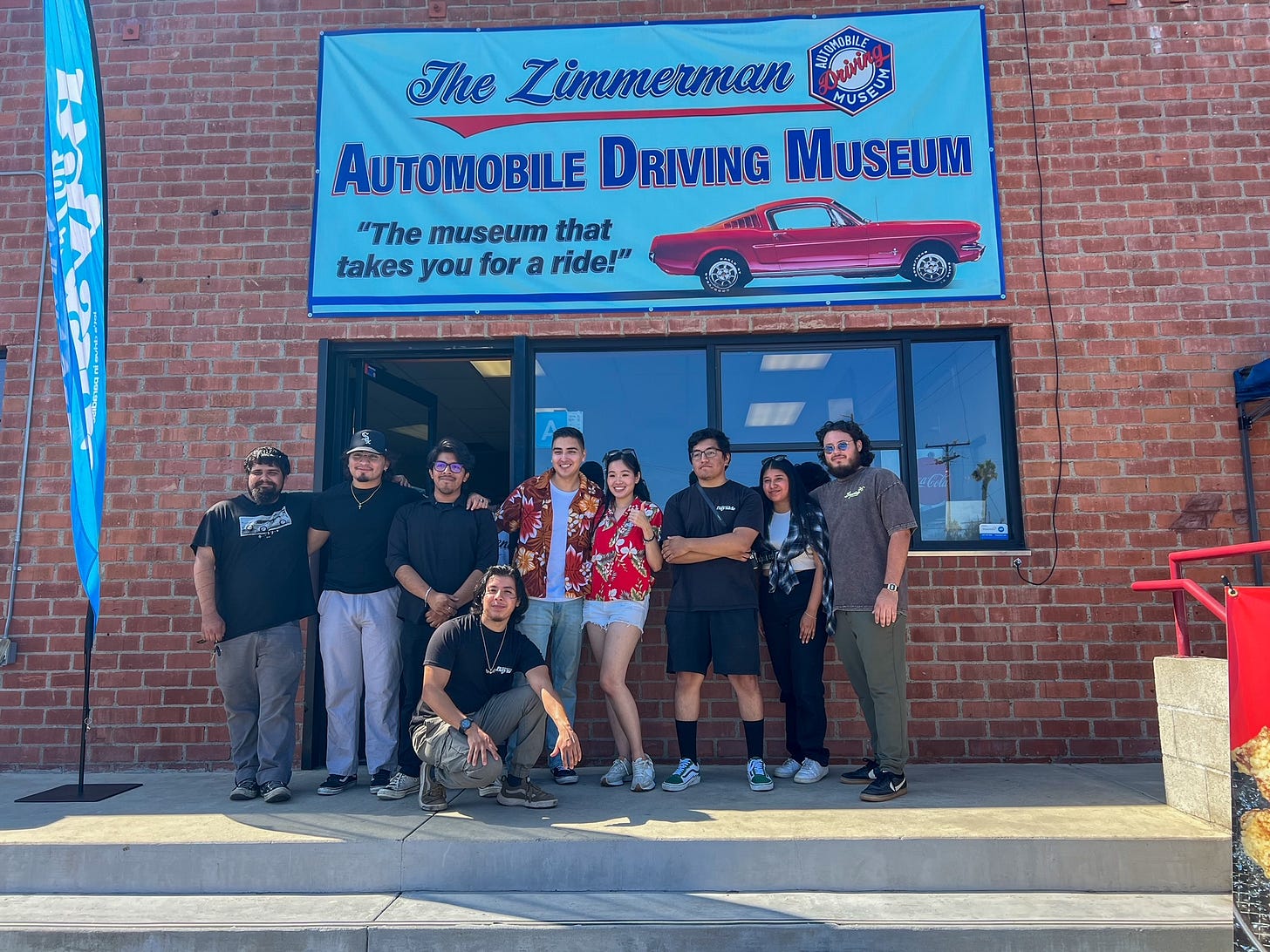Car Media Botched this Week's News 😡
How did the shuttering of an auto-media pioneer fly under the radar?
HAPPY RACE DAY! especially to those of you headed to the 19th annual Japanese Classic Car Show, coming up this October 12th right in my backyard of Long Beach. This year it’s even more special, because Carrara Media is proudly making its debut as an official vendor and sponsor!
We’ll have books for sale, loads of new merch and some absolutely epic cars. There may even be a surprise or two you won’t want to miss. But most of all, I’m incredibly proud to have the opportunity to participate with JCCS after so many years of fun as an attendee. We’ll see you out there! You can buy tickets here.
In today’s email: 👇
New podcasts for your jog: Where to hear Carrara authors.
Entire staff of Autoblog is laid off: And the consequences.
Cybertruck turned to Cyberpieces: The hottest video of the week.
New Podcasts!
You can find authors of Carrara Media books on audio! Here are our latest appearances:
Victoria Scott discusses We Deserve This on the Seattle Now podcast
Kevin McCauley discusses Waiting for the Sun to Come Down on the Cars Yeah podcast
Ryan ZumMallen discusses Cult of GT-R on the Avants podcast
For a full list of author podcast appearances, check out our Press page.
How to Cheapen an Industry
The hottest story in automotive journalism this week was the departure of video host James Pumphrey, who left Donut Media to start his own venture after nearly a decade of turning Donut into the biggest, and possibly most-influential, brand in the industry. The news launched a thousand takes and drew 4.2 million views and counting to his goodbye video.
It was so hot, in fact, that it completely eclipsed a far more important story.
On roughly the same day that Pumphrey announced his decision, the news website Autoblog laid off its entire editorial staff. Founded in 2004, Autoblog helped pioneer the “blog” era of automotive media, defined by churning out a huge number of short-form news bites paired with reviews and industry analysis. It became a traffic giant, and stole big names away from prestige outlets while launching the careers of many others. In a post this past June celebrating the site’s 20th anniversary, the editor-in-chief wrote, “And we’re just getting started.”
The site is still posting as we speak, but sometime in September the lights will go out, closing the book of one of the most influential automotive websites since the turn of the century. It currently lists an editorial team of eight people, plus a video team of four and about 10 other staffers – all of whom are about to hit the job market.
Automotive media lost not just another outlet, but an institution. And institutions are important because they’re becoming rarer and rarer. Yahoo Autos shut down in 2016, CNET Roadshow closed in 2022, and the parent company of Motor Trend once shuttered 22 magazines all at once. Adding Autoblog to the list creates quite a pool. Sites that dominated the early 2010s are also hanging on for dear life. Jalopnik and The Drive have both gone through layoffs in recent years. It’s difficult to look around and not feel that the auto media world is imploding. Or at least eroding.
Autoblog passed around from owner to owner. The site had been previously owned by Verizon, AOL and others until it was acquired by Yahoo. In 2021, Yahoo was sold to a company called Apollo Global Management, making Apollo effectively the owner of Autoblog. And that’s notable because Apollo is one of the largest private equity firms in the world.
I wrote back in February about the growing presence of private equity in automotive media and the threat that it poses to the industry. There hasn’t been an official statement on the future of Autoblog or what led to the decision (my calls to Apollo’s media relations team went unanswered), but the fact that Apollo missed its second-quarter earnings target last week may have been a factor. This time last year, Yahoo was flush with cash from Apollo and in the middle of a buying spree, acquiring new sites left and right. And Apollo couldn’t have been happier, commenting that its purchase of Yahoo was “one of its fastest ever returns on investment.” One year later, more than a dozen people are out of a job.
Such is the danger of chasing daily traffic targets fueled by the all-powerful Google algorithm. If you have a staff of writers tasked to pump out stories, optimized to hit the metrics that Google has deemed important, you place yourself at its mercy. One small change in the algorithm could leave you hanging out to dry, until you restructure your writing format to get back on Google’s good side. So writers are trained to stuff their articles with keywords, optimize the word count for searchability, and write easy-to-understand news bites with clearly defined subheadings. They are being trained to write like an algorithm. They are being trained to be replaced by A.I. (Another blog-era giant, The Truth About Cars, recently began using A.I. to write articles with editorial oversight.)
It’s now a pattern that high-churn automotive websites meet the chopping block faster than others. When websites race to produce as many stories as possible, even if the content is valuable, it’s presented as disposable. You produce so much content that the content essentially becomes missable. And then forgettable. And you’ve effectively devalued content to the point of worthlessness.
Still, sites like Autoblog served an important purpose. As mentioned earlier, it launched the careers of plenty of established writers, who took what they learned and brought it with them in their careers, sharing that institutional knowledge along the way. Things like fact-checking practices and journalistic standards. Its loss means that another brand capable of developing talent, and offering opportunity to young writers looking to learn the ropes, is now gone. Ten years ago, a journalism graduate could email Autoblog, Yahoo Autos and CNET Roadshow to get their foot in the door. Now they’re gone, and nothing new has taken their place.
This has led to the independent creator. As people looking to get into automotive media saw dwindling full-time opportunities, they’ve been pushed instead into freelancer roles or social media content. My role as President of the Motor Press Guild has put me in contact with dozens of writers, photographers and creators who’ve established themselves on social media and are looking for the payoff of a full-time job. But there’s often nowhere to point them. The more institutions that close up, the fewer positions out there.
As we’ve steadily devalued content, we’ve funneled young talent toward this role instead. Whether you use the term independent creator, gig-worker or freelancer, the key is that this path has become less of a career and lifestyle choice, and more of a mandate.
That may not seem like a bad thing. You can certainly make a career out of building a social media following these days, or hitting it big on YouTube. The problem is that, from time to time, we do still need writers and reporters. And with fewer institutions taking time to invest and mentor new hires, there are fewer skills and standards being passed down to a new generation. And that’s how you end up with another phenomenon that happened last week.
Dropping the Bankruptcy Ball
In quick succession, the automotive aftermarket brands BBS and Recaro, along with the sim racing giant Fanatec, all entered insolvency in Germany. Bankruptcy announcements quickly spread to automotive news sites, who rushed to post a story. The problem is that few of them aimed to be right. Because as writers began to post that the companies were “biting the dust” or speculated whether they would “outright cease to exist,” it was later revealed that both the BBS and Recaro bankruptcies were limited to specific German branches and that North American operations for BBS and Recaro were unaffected. Many outlets posted updates once executives reached out to clarify. (Though they should have posted re-written corrections.)
Mistakes happen in journalism. When you become a reporter you’re signing up to get raked over the coals once in a while. Lord knows I have. But we’re going to see this more and more, with the demand for increased content, a lack of oversight, and vanishing institutional knowledge across the industry. It’s a recipe for hot takes and open-ended speculation without so much as a follow-up phone call. We’ve driven the value of content down so low that when the time comes for independently sourced, high-value content, we’re not capable of producing it.
Plenty of articles placed the blame for BBS, Recaro and Fanatec troubles on private equity. And to be sure, P.E. played a significant role in each of those bankruptcies. But there are other forces too. For instance, all three companies that filed were based in Germany, where business is a challenge to say the least. The economy stagnated during the pandemic and has been slow to recover, and economic advisors in May reduced the country’s growth forecast to just 0.2% for 2024. “A tough financial climate impacted by global events is believed to have irreparably damaged many firms,” the German state-owned network Deutsche Welle wrote. The effects aren’t only hitting a few select companies – the massive automotive supplier ZF Friedrichshafen announced plans recently to slash up to 14,000 jobs by 2028.
The U.S. automotive aftermarket is not so rosy itself. The Specialty Equipment Manufacturers Association, or SEMA, found in its 2024 State of the Industry report that 53-percent of aftermarket manufacturers saw sales stagnate or decrease last year:
In the seats market, where Recaro competes, revenue increased overall but only 38-percent of companies saw growth.
In the wheels market, where BBS competes, that number fell to 26-percent.
This echoes what many companies relayed to me at the SEMA Show in Las Vegas last November, where they acknowledged that while the industry was experiencing overall growth (the report predicts a 2% increase to more than $53 billion in 2024 U.S. sales), many brands were reeling after an economic slowdown put a dent in discretionary consumer spending.
Where That Leaves Us
Automotive outlets will often brand themselves as “enthusiast sites.” But that is not a license to spout unsourced theories. It doesn’t change the fact that they are still, effectively, business journalism sites. If you cover the automotive industry, you are a business journalist. And for that you need an understanding of nuanced economic forces, or at least the willingness to pick up the phone and have someone explain so you can explain them to readers. Unfortunately that is going to continue to be a tall ask for many writers, as they’re left to operate without experienced editors or proper training. We’ve chased the allure of web traffic down a rabbit hole from which it’s going to be very difficult to climb out.
Much of the attention has moved away from those sites as primary conversation-drivers, and migrated over to YouTube creators. The departure of Pumphrey from Donut followed a similar move from his former co-workers, Zach Jobe and Jeremiah Burton, when they left to start the channel BigTime. All this comes a few months after Hoonigan lost about a half-dozen former video hosts to pursue their own independent channels. They created so much brand recognition around their own names that at a certain point it didn’t make sense not to strike out independently.
It’s trickier for writers and reporters. Name recognition is tough to build, and it’s expensive and time-intensive to strike out on your own with less guarantee that there are YouTube-sized traffic numbers waiting for you. The rise of video and the consistent degradation of traditional online media has left automotive journalism in a shaky state. But I want to value written content again. The answer may be that journalists become Swiss Army knives of independent tools like newsletters, podcasts, books and the occasional video or two to build empires of their own. I can see that path being the way forward for a select group willing to lay the groundwork.
But for the rest, it’s looking more and more dire. Writers will watch more friends and colleagues endure layoff after layoff until one day they look around and realize they’re the only ones keeping the light on. I suppose that’s better than young journalists looking to get into writing. They may start hunting jobs at established companies in search of guidance and experience, and find only ghosts instead.
Ask A Millennial! Jonathan Lucero, 24
Jonathan Lucero is technically Gen Z, but we’ll include him as part of our “young enthusiast” interview series. And with good reason, because the 24-year old graphic designer recently opened a coffee shop for his brand Bayside at an unlikely place — the Zimmerman Automobile Driving Museum in El Segundo, near Los Angeles. Here’s an edited version of our conversation about why this was the right fit.
It was the culmination of a very ambitious project. Months of planning, designing, scheduling — all coming together. I was super happy we had a good turnout. I got here at 6:00am, and the night before I was here at midnight so instead of sleeping I really just took a nap. It was the first time for me putting on the business hat and going around greeting folks. Everyone was asking about working with Bayside, and it was eye-opening to hear the word constantly being said because for a long time it was a sparkle in my eye. The cafe helped solidify the message and the vision. It was one of the best moments of my life.
The museum director Marisol Herrera asked if I wanted to have a ribbon cutting. I said, “What do you mean? You can just ask them to do that?” So she put us in touch with the Chamber of Commerce. It’s super funny to me that that’s how it works. It was goofy holding those big scissors.
The museum’s global message is to preserve the automobile and educate the world. Bayside acts as a new open door for the younger audience, allowing more people to walk through the doors and get engulfed in the world of automotive. They see what we promote, like Japanese cars, and then go into the museum and see cars they’ve never seen before like a Model T. The cafe brings them through the door and hopefully they see it’s like Disneyland and want to come again. I’m glad my brand can act like that.
Bayside represents the fusion between the surfer, “beach boy” lifestyle and the tuner enthusiast. I’ve always had a love for Japanese tuner cars and 1950s hot rods. In SoCal the hot rods are all right by the beach. And I’m a big fan of having fun and seeing other people having fun. The slogan “Let’s drive in paradise” represents your dream drive, your dream location, whether it’s the mountains or the beach or the city at night — the slogan is universal. Let’s go drive in your fantasy, your paradise. To me it’s the beach but its all about inclusivity, I hate leaving people out. Let’s all get together and have a good time. Also my favorite sitcom is Saved By The Bell.
Everyone’s trying to start a brand but a lot of people get lost in the financial side. You can only run something off hopes and dreams for so long. You start to realize you’ve gotta make some income, so you do social media to start a membership or sell a lot of merch. People get lost in that and want to make a private group and charge X amount. I’ve met a lot of enthusiasts that get bummed out because they’re fans of the cars, but they don’t feel included. That’s the new wall nowadays — everything needs a membership or recurring fee. It’s a tight wire to walk because you have to set walls in place to make ends meet but I try to do my best with free beach drives, and the cafe is a nice natural way to keep the transaction with a cup of coffee. I try to make sure if people want to invest in Bayside then it’s the very best we can provide. We’re trying to build an experience and trust with our fans.
Read our past interviews:
And Finally…
It didn’t get bigger or more outrageous than the notorious YouTuber known as Whistlin Diesel putting a Tesla Cybertruck through zany and ridiculous challenges. He called it a durability test. I would call it intentional destruction.
Not to say it’s not valuable! I learned tons about the Cybertruck. Most of it confirms the skepticism I’ve held since the infamous “broken window” debut. But this video made that look like cake by comparison. Sit back and enjoy the fireworks.
Thanks for reading. Please consider sharing our newsletter with your friends.
Drive hard and be safe. Black Lives Matter.
Check out Carrara Media on Instagram, Twitter and Facebook and visit our store to order one of our many fine books and eBooks.







